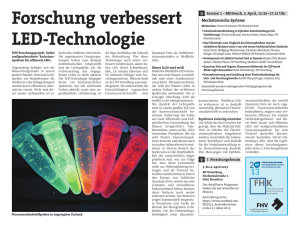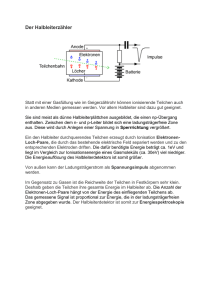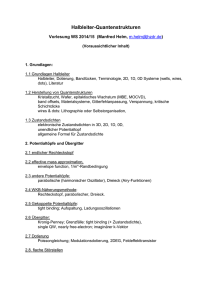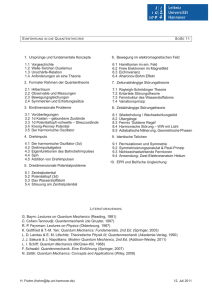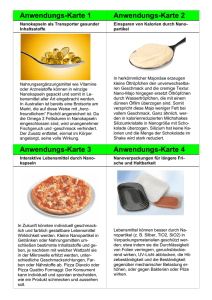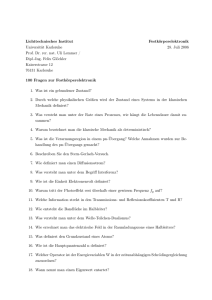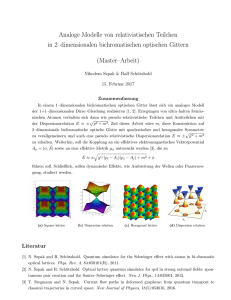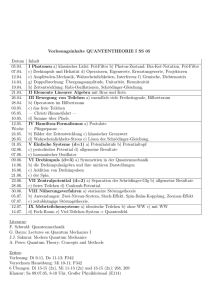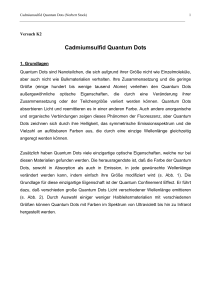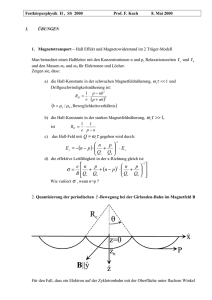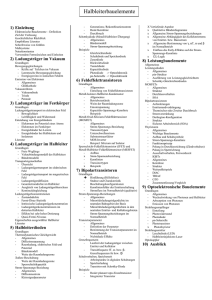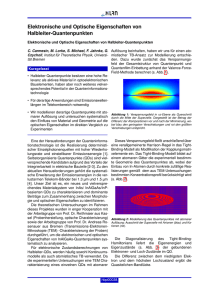V04 - TU Chemnitz
Werbung
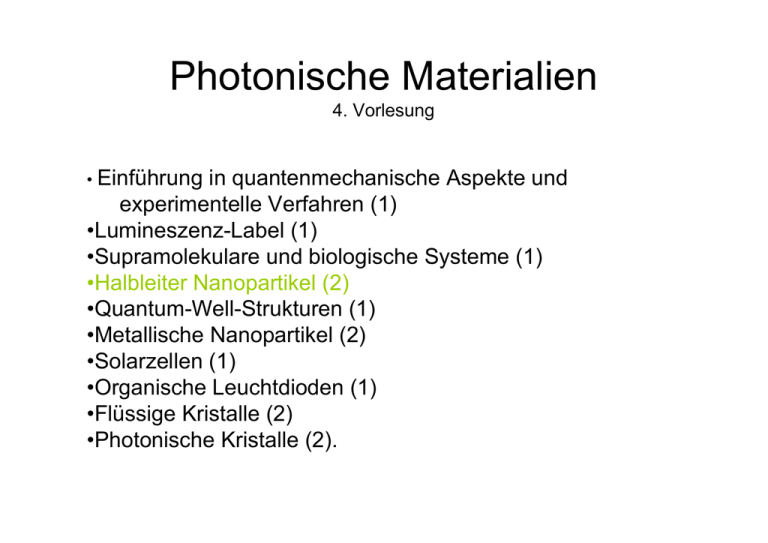
Photonische Materialien 4. Vorlesung • Einführung in quantenmechanische Aspekte und experimentelle Verfahren (1) •Lumineszenz-Label (1) •Supramolekulare und biologische Systeme (1) •Halbleiter Nanopartikel (2) •Quantum-Well-Strukturen (1) •Metallische Nanopartikel (2) •Solarzellen (1) •Organische Leuchtdioden (1) •Flüssige Kristalle (2) •Photonische Kristalle (2). Übungen • 1 – stündig • „Praktikumsversuch“ • Literaturstudium zu einer angewandten Fragestellung mit Kurzreferaten • Termin nach Absprache, auch in Kompaktform • Heute 16:45 Besprechung Supramolekulare und biologische Systeme 1. 2. 3. 4. Photosynthese Selbstorganisation Organisationsprinzipien Beispiele o h r e d e i W g n lu BASIC PRIMARY PHOTOSYNTHETIC EVENTS Anregungsenergietransfer Primäres Reaktionszentrum SAM Halbleiter Nanopartikel • Warum Nanopartikel ? – Volumen – Oberflächenverhältnis – Qualitative Änderung von Eigenschaften • • Beispiele Vom Atom zum Festkörper – „quantum size“ Effekte • Optische Eigenschaften – Exzitonen – Transport • Silizium Nanopartikel – Poröses Silizium – Nanokristalle • Kolloidale Halbleiter – Oberflächen – Photolumineszenz-Eigenschaften • Epitaktische Halbleiter Warum Nanopartikel? • Nano entspricht – – – – 10 -9m = 1 nm Atomdurchmesser Silizium (Si): 0,12 nm Bindungslänge Si-Si: 0,233 nm Grobe Abschätzung Würfel • Durchmesser d =10 nm: ca 80.000 Si Atome • Durchmesser d= 1nm: ca 100 Si Atome, alle an der Oberfläche – Atomgewicht: 28,09 g/mol • 1 mg entspricht ca 2 10 19 – Kristallstruktur beachten Si Atomen Warum Nanopartikel? • Qualitative Änderung von Eigenschaften als Funktion der Größe, z.B. – Leitfähigkeit – „Farbe“ – Thermische Eigenschaften • Oberflächen : Volumenverhältnis – (reaktive) Grenzflächen – Interface Oberflächen reaktiv !! Passivierung: H, O In the basic unit of a crystalline silicon solid, a silicon atom shares each of its four valence electrons with each of four neighboring atoms Eigenschaften • Elektrische Leitfähigkeit – Ohmscher Widerstand eines makroskopischen Drahts: R = ρ Länge l/Querschnitt A – Einzelelektronen Transistor Coulomb - Blockade Tunnelmikroskopie STM Eigenschaften • Optische Eigenschaften – Absorption • Metalle • Halbleiter – Emission • Halbleiter – Streuung • Metalle Semiconductor Quantum - Dots Linnros Meier CdSe Silicon Größenabhängige Farbe Vom Atom zum Festkörper Halbleiter leer voll Quantum Confinement Quantum Confinement Bulkcrystal 3D E Thin film Quantum wire Quantum dot 2D 1D 0D E E 1/2 E N(E) Example: CdSe N(E) E E-1/2 N(E) N(E) Tunneln Bandgap Engineering Energy Electron-hole pair CdSe ZnS CB EB EG,Bulk VB Size dependence Halbleiter Quantum Dots (QD’s) : Quantenpunkte Eg H = − Eg e2 h2 h2 ∇ e2 − ∇ 2 − h 2m e 2m h ε 2 re − rh h 2π 2 E10 = 2R 2 Eg + V e (r e ) + V h (r h ) ⎡ 1 1 ⎤ 1.786 e 2 * + − 0.248 E Ryd ⎢ ⎥− ε2R ⎣ me m h ⎦ Exzitonen:Quantum Confinement eElektron - Lochpaar aB h+ eaB h+ eaB Wannier Exziton: „H_Atom“: Halbleiter h+ Frenkel Exziton: Lokalisierung: Moleküle Anregungsenergietransfer Energieskalen • 1 eV (Elektronenvolt) = ca 8000 cm • 20 000 cm -1 = ca 500 nm -1 Übergangänge zwischen Bändern Photolumineszenz e d c b a PL Intensity (a.u.) Absorbance (a.u.) CdSe a b c d e 0 0 350 400 450 500 550 600 650 700 750 Wavelength (nm) 450 500 550 600 650 Wavelength (nm) Absorption (left) and PL (right) spectra of alloyed Zn xCd 1-xSe QDs 2 nm a 5.2 nm CdSe b 5.8 nm Zn0.28Cd0.72Se Knoll, MPI Mainz c 6.3 nm Zn0.44Cd0.56Se d 6.8 nm Zn0.55Cd0.45Se e 7.5 nm Zn0.67Cd0.33Se (c) (b) (a) Normalized PL intensity (a.u.) (d) ZnXCd1-xS alloy QDs Emission a 474nm b 442nm c 417nm d 391nm 350 400 450 wavelength / nm 500 fwhm 14nm 16nm 17nm 18nm 550 x 0.10 0.25 0.36 0.53 Kristallstrukturen ZnS, ZnSe, ZnTe, CdS, CdSe, CdTe. Kristall - Facetten CdSe nanocrystal, 66 atoms 45 40 35 30 25 20 15 10 5 0 -2 -1 0 1 energy, eV 2 3 4 Core-shell QD SemiconduKolloidale Quantendots Nanocrystals CdSe/ZnS Kolloidale Quantumdots Transmission Electron Microscope Image: D = 4.56 nm Hietschold, TU Chemnitz Core – shell Systeme P P o o o o o P CdSe o P o P P P P P o o o P CdSe core diameter ~ 2.69 nm P o oo ZnS o P P o o P P P Kolloidale Quantum Dots - Oberfläche H 3C H 3C H 3C CdSe Core ZnS Shell P Attach to the surface Some TOPO desorb O TOPO Evident Technologies, Inc. „extended“ Wavefunction Tunneling Dunkel-Zustände Photophysikalische Prozesse in Quantendots (i) Radiative recombination (ii) Nonradiative recombination (iii) Trap processes Quntendots in Lösungen Spin Coating Matrix-isolierter Quantendot •Ionenimplantation •Dotierung + Tempern QDs Oligo target 1 2 3 4 Oligo-probe Streptavidin matrix Binary thiol layer Au - surface Schematic illustration of the interfacial multilayer architecture for the fluorescence detection of hybridization events. Stranski-Krastanow Wachstum z.B. InGaAs on GaAs SiGe on Si Uncapped indium arsenide (InAs) self-assembled quantum Dots grown on gallium arsenide (GaAs). Oliver G. Schmidt images.pennnet.com Caption: Micrograph of pyramid-shaped quantum dots grown from indium, gallium, and arsenic. Each dot is about 20 nanometers wide and 8 nanometers in height. QD - Leuchtdioden DEAK-LAM, Inc. New York.......Hong Kong........London QD - Devices www.fujitsu.com Indirekte Bandübergänge: Si Si Quantendots Christian von Borczyskowski Si - Bandübergänge
